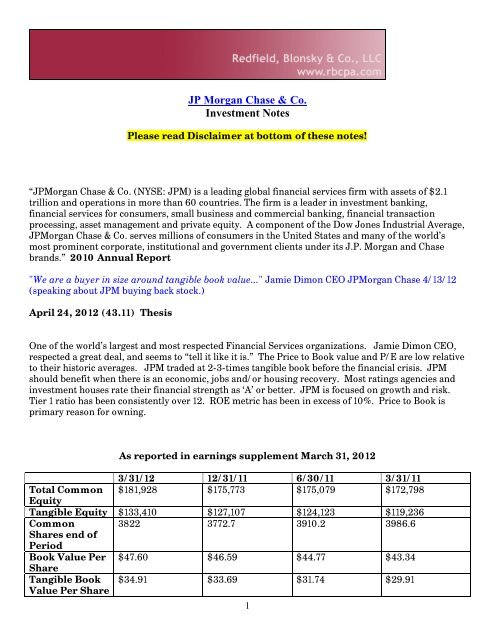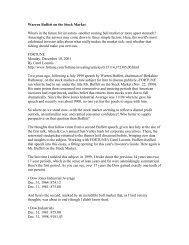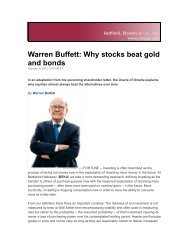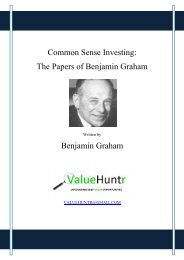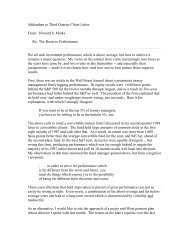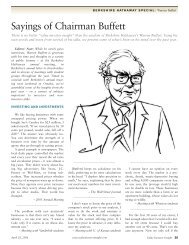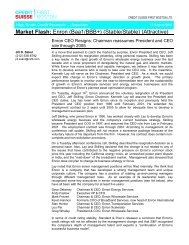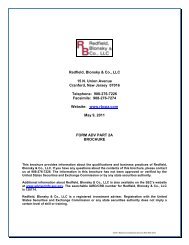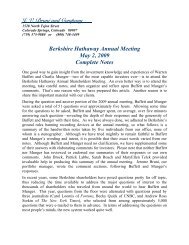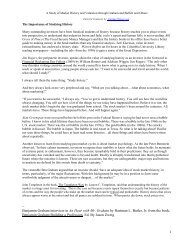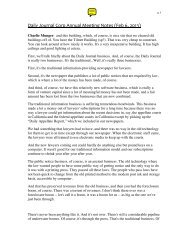JP Morgan Chase & Co. Investment Notes - Redfield, Blonsky & Co.
JP Morgan Chase & Co. Investment Notes - Redfield, Blonsky & Co.
JP Morgan Chase & Co. Investment Notes - Redfield, Blonsky & Co.
Create successful ePaper yourself
Turn your PDF publications into a flip-book with our unique Google optimized e-Paper software.
<strong>JP</strong> <strong>Morgan</strong> <strong>Chase</strong> & <strong>Co</strong>.<br />
<strong>Investment</strong> <strong>Notes</strong><br />
Please read Disclaimer at bottom of these notes!<br />
“<strong>JP</strong><strong>Morgan</strong> <strong>Chase</strong> & <strong>Co</strong>. (NYSE: <strong>JP</strong>M) is a leading global financial services firm with assets of $2.1<br />
trillion and operations in more than 60 countries. The firm is a leader in investment banking,<br />
financial services for consumers, small business and commercial banking, financial transaction<br />
processing, asset management and private equity. A component of the Dow Jones Industrial Average,<br />
<strong>JP</strong><strong>Morgan</strong> <strong>Chase</strong> & <strong>Co</strong>. serves millions of consumers in the United States and many of the world’s<br />
most prominent corporate, institutional and government clients under its J.P. <strong>Morgan</strong> and <strong>Chase</strong><br />
brands.” 2010 Annual Report<br />
"We are a buyer in size around tangible book value..." Jamie Dimon CEO <strong>JP</strong><strong>Morgan</strong> <strong>Chase</strong> 4/13/12<br />
(speaking about <strong>JP</strong>M buying back stock.)<br />
April 24, 2012 (43.11) Thesis<br />
One of the world’s largest and most respected Financial Services organizations. Jamie Dimon CEO,<br />
respected a great deal, and seems to “tell it like it is.” The Price to Book value and P/E are low relative<br />
to their historic averages. <strong>JP</strong>M traded at 2-3-times tangible book before the financial crisis. <strong>JP</strong>M<br />
should benefit when there is an economic, jobs and/or housing recovery. Most ratings agencies and<br />
investment houses rate their financial strength as ‘A’ or better. <strong>JP</strong>M is focused on growth and risk.<br />
Tier 1 ratio has been consistently over 12. ROE metric has been in excess of 10%. Price to Book is<br />
primary reason for owning.<br />
As reported in earnings supplement March 31, 2012<br />
3/31/12 12/31/11 6/30/11 3/31/11<br />
Total <strong>Co</strong>mmon $181,928 $175,773 $175,079 $172,798<br />
Equity<br />
Tangible Equity $133,410 $127,107 $124,123 $119,236<br />
<strong>Co</strong>mmon 3822 3772.7 3910.2 3986.6<br />
Shares end of<br />
Period<br />
Book Value Per $47.60 $46.59 $44.77 $43.34<br />
Share<br />
Tangible Book<br />
Value Per Share<br />
$34.91 $33.69 $31.74 $29.91<br />
1
Tier 1 Capital 12.6 12.3 12.4 12.3<br />
Ratio<br />
Price Per Share $45.98 $33.25 $40.94 $46.10<br />
Close<br />
P/BV 0.97X 0.7136 0.9145 1.064<br />
P/TBV 1.32X 0.987 1.29 1.54<br />
Net Income per $1.31 $0.90 $1.27 $1.28<br />
Share<br />
ROE 12% 8% 12% 13%<br />
I project earnings for 2012 of $4.50 - $5.00 per share. Based on current price, P/E would be in range<br />
of 9.6X – 8.6X. I would not think of selling this below 1.5X Book Value or ~$71.50, or P/E of 15,<br />
which would indicate a price of ~$71.25.<br />
April 27, 2011 (45.08) Thesis<br />
One of the worlds largest and most respected Financial Services organization. Jamie Dimon CEO,<br />
respected a great deal, and seems to “tell it like it is.” Great shareholder letters. Price to Book value<br />
and P/E low per average of past. Should benefit in economic, jobs and housing recovery. Most<br />
agencies and investment houses rate their financial strength as ‘A’ or better. Focused on growth and<br />
risk. Fortress balance sheet. ROE metric at 10%. Price to Book is primary reason for owning. Has<br />
often been priced in the past at 1.5X Book Value.<br />
November 14, 2011 (32.55) Review of VL 11/18/11<br />
1. Projecting F2011 and F2012 earnings of $4.50 to $4.70 respectively. Previous was $4.90<br />
and $5.20, respectively.<br />
2. Dividend of $1.00 is 3.07%.<br />
3. Book Value F2011 of $46.65 intangibles of $15.64, for TBV of $31.01.<br />
4. ROE projected at 10.5% for F2011 and 9.5% for F2012.<br />
5. “<strong>Co</strong>nservative investors may want to stay on sidelines.”<br />
August 24, 2011 (35.29) Review of VL 8/19/11<br />
1. Projecting F2011 and F2012 earnings of $4.90 to $5.20 respectively. Previous was $5.00 and<br />
$5.50, respectively.<br />
2. Dividend of $1.00 is a yield of 2.7%.<br />
3. Book Value F2011 of $46.70 intangibles of $16.57, for TBV of $30.13.<br />
4. ROE projected at 11% for F2011 and 10.5% for F2012.<br />
5. Net of hedging, VL expects worst case Europe scenario to be $3B. This is consistent with what<br />
Jamie Dimon has recently discussed.<br />
June 20, 2011 (40.76) <strong>Notes</strong> to Morningstar Report 6/8/11 – Nothing to add.<br />
2
May 25, 2011 (42.69) Review of VL 5/20/11<br />
1. Projecting F2011 and F2012 earnings of $5.00 and $5.50, respectively.<br />
2. Dividend of $1.00 is a yield of 2.2%.<br />
3. Book Value F2011 of $47.30, intangibles of $16.51, for TBV of $30.79.<br />
4. ROE projected at 11% for F2011 and F2012<br />
April 27, 2011 (45.08)<br />
Fundamental Analysis<br />
<strong>Co</strong>mpany Name<br />
Symbol<br />
Date Worked On<br />
Base Year<br />
<strong>JP</strong> <strong>Morgan</strong><br />
<strong>Chase</strong><br />
<strong>JP</strong>M<br />
27-Apr-11<br />
3-Jul-05<br />
Price $45.52<br />
Shares Outstanding 4,014<br />
Market Capitalization $182,722<br />
Cash and CE $104,311<br />
Long Term Debt $269,616<br />
Minority Interests $0<br />
Goodwill $48,856<br />
Intangibles $3,857<br />
Other Intangibles $13,093<br />
Enterprise Value $348,027<br />
Short Term Debt $0<br />
Stockholders Equity $180,598<br />
Depreciation and Amortization $5,000<br />
CapEx $0<br />
3
Revenues $100,000<br />
Total Assets $2,117,605<br />
Net Income $19,600<br />
Dividend $1.00<br />
Interest Expense $12,781<br />
Net Income Before Taxes $24,859<br />
Enterprise Value Per Share $86.70<br />
Price To Enterprise Value 52.50%<br />
Total Debt $269,616<br />
Total Debt / Net Income 1375.59%<br />
Total Debt Per Share $67.17<br />
Tangible Book Value $114,792<br />
Book Value Per Share $44.99<br />
Tangible Book Value Per Share $28.60<br />
Price / Book Value 101.18%<br />
Price / Tangible Book Value 159.18%<br />
Price / Earnings Ratio 9.32<br />
Enterprise Value / Earnings<br />
Ratio 17.76<br />
Earnings Yield 10.73%<br />
Price To Sales Ratio 182.72%<br />
Net Income / Total Assets 0.93%<br />
Total Assets / (Revenues/365) 7729.26<br />
Enterprise Value / Revenues 348.03%<br />
Goodwill / Total Assets 2.31%<br />
Goodwill / Stockholders Equity 27.05%<br />
4
Debt / Equity 149.29%<br />
Average P/E Last 10 Years 0.0<br />
Cash Flow $24,600<br />
Cash Flow Per Share 6.13<br />
Cash Flow Yield 13.46%<br />
Price / Cash Flow 7.43<br />
Revenues Per Share $24.91<br />
Net Income Per Share $4.88<br />
Return on Equity 10.85%<br />
Bond Rating (S&P)<br />
Growth Rate 5.00%<br />
Dividend Yield 2.20%<br />
Dividend / Net Income 20.48%<br />
Dividend / Cash Flow 16.32%<br />
Interest <strong>Co</strong>verage Ratio 2.94<br />
Insider Activity<br />
Buy-Backs<br />
Dilution<br />
Management <strong>Co</strong>mpensation<br />
Neutral to<br />
Positive.<br />
claims will happen<br />
No<br />
Fair for sure<br />
Price to buy more $45.00<br />
Price to sell or consider<br />
reducing $60.00<br />
Action (Buy, Hold or Sell)<br />
Buy<br />
Portfolio Allocation Suggestion 5%<br />
5
Valuation Analysis<br />
<strong>Co</strong>mpany<br />
<strong>JP</strong> <strong>Morgan</strong> <strong>Chase</strong><br />
As of Date March 31, 2011<br />
EV Analysis<br />
April 27, 2011<br />
Share Outstanding 4,014.10<br />
Share Price $60.00<br />
Market Capitalization $240,846.00<br />
Less: Cash and Short Term<br />
<strong>Investment</strong>s $0.00<br />
Add: Long Term Debt $0.00<br />
Minority Interest $0.00<br />
Enterprise Value $240,846.00<br />
EV per share $60.00<br />
Stockholders' Equity $180,598.00<br />
Adjustments:<br />
Goodwill ($48,854.00)<br />
Mortgage Servicing Rights ($13,649.00)<br />
Other Intangibles ($4,039.00)<br />
Net Stockholders' Equity $114,056.00<br />
Adjusted Book Value per Share $28.41<br />
Quick Projections 2011 April 27, 2011<br />
Revenue $100,000.00<br />
Net Margin % before tax 28.00%<br />
Net Margin before taxes $28,000.00<br />
Tax Rate 30.00%<br />
<strong>Co</strong>rporate Taxes $8,400.00<br />
6
Net Income after Taxes $19,600.00<br />
Net Margin % 19.60%<br />
Shares Outstanding 4,014.10<br />
eps $4.88<br />
FV of current equity and future earnings<br />
27-Apr-11<br />
Adjusted Stockholder's Equity $114,056.00<br />
Net Income after Taxes $19,600.00<br />
Growth Rate of Net Profit for 10N 5.00%<br />
Growth Rate of Net Profit after 10N through 15N 5.00%<br />
FV of Net Profit in 10N $31,926.33<br />
FV of Net Profit in 15N $40,746.99<br />
FV of tangible book value plus Net Profits for 10N $432,311.90<br />
FV of tangible book value plus Net Profits for years 11 - 15N $728,164.86<br />
Current Enterprise Value $240,846.00<br />
FV of tangible book value plus Net Profits for 10N ($432,311.90)<br />
Years 10<br />
ROI on tangible book value plus Net Profits for 10N 6.02%<br />
FV of tangible book value plus Net Profits for 10N $432,311.90<br />
FV of tangible book value multiplier 1.20<br />
FV of Tangible Book Value using BV multiplier in year 10 $518,774.28<br />
Current Enterprise Value $240,846.00<br />
FV of tangible book value plus Net Profits for years 11 - 15N ($728,164.86)<br />
Years 15<br />
ROI on tangible book value plus Net Profits for 15N 7.65%<br />
FV of tangible book value plus Net Profits for 15N $728,164.86<br />
FV of tangible book value multiplier 1.2<br />
FV of Tangible Book Value using BV multiplier in year 15 $873,797.83<br />
Potential Future EV using BV multiplier above<br />
Current Enterprise Value $240,846.00<br />
FV of Tangible Book Value using BV multiplier in year 10 ($518,774.28)<br />
Years 10<br />
ROI on FV of Tangible Book Value using BV multiplier in year 10 7.98%<br />
7
Current Enterprise Value $240,846.00<br />
FV of Tangible Book Value using BV multiplier in year 15 ($873,797.83)<br />
Years 15<br />
ROI on FV of Tangible Book Value using BV multiplier in year 15 8.97%<br />
Sanity Checks:<br />
P/E in future<br />
FV of Net Profit in 15N $40,747<br />
P/E estimate 13.00<br />
Market Cap on above -$529,711<br />
Years 15<br />
Current Enterprise Value $240,846<br />
ROI in 15N using above 5.39%<br />
Potential Revenue Growth<br />
Current Revenues $100,000<br />
Growth Rate of Revenues for 10N 5.00%<br />
Growth Rate of Revenues after 10N through 15N 5.00%<br />
FV of Revenues in 10N ($162,889)<br />
FV of Revenues in 15N $207,893<br />
FV of Revenues in 15N $207,893<br />
Revenue Multiplier based on Al Meyer Rule of Thumb net margins 4<br />
Possible Market Cap year 15 ($831,571)<br />
Years 15<br />
Current Enterprise Value $240,846<br />
ROI in 15N using above 9%<br />
Intrinsic Value Analysis<br />
<strong>Co</strong>mpany<br />
<strong>JP</strong> <strong>Morgan</strong><br />
Report Date<br />
27-Apr-11<br />
Price 45.57<br />
Growth Rate 5.00%<br />
Price/Sales 1.82<br />
Price/ Net Cash Flow 7.43<br />
8
Price/ Net Book Value 1.59<br />
P/E Ratio Current 9.40<br />
P/E Ratio Year 2 8.14<br />
Current Ratio<br />
#DIV/0!<br />
Quick Ratio<br />
#DIV/0!<br />
LT Debt / Shr. Equity 140.64%<br />
LT Debt / Current Assets #DIV/0!<br />
Return on Shr. Equity 10.85%<br />
PEG Ratio (Current) 1.88<br />
PEG Ratio Year 2 1.63<br />
PEGY Ratio (Current) 1.31<br />
PEGY Ratio Year 2 1.13<br />
Graham Ratio (current) 14.97<br />
Graham Ratio Year 2 12.97<br />
Growth Flow Ratio<br />
( 10 % ) 24.52%<br />
Flow Ratio (s/b < 1.25 ) #DIV/0!<br />
Intrinsic Value (current) 71.78<br />
Intrinsic Value Year 2 82.88<br />
Intrinsic Value Year 3 87.02<br />
Intrinsic Value Year 4 91.38<br />
Intrinsic Value Year 5 95.94<br />
Intrinsic Value / Price<br />
(current) 57.52%<br />
Intrinsic Value / Price Year 2 81.87%<br />
Intrinsic Value / Price Year 3 90.97%<br />
Intrinsic Value / Price Year 4 100.52%<br />
Intrinsic Value / Price Year 5 110.54%<br />
Review of Value Line 2/18/11<br />
1. “Investors reacted favorably after banking giant <strong>JP</strong><strong>Morgan</strong> <strong>Chase</strong> posted better-than-expected<br />
March-quarter earnings of $1.28 a share. Reported results both exceeded our estimate of $1.00 and<br />
pulled well ahead of earnings of $0.74 in the year-earlier quarter.<br />
A $2 billion reduction in the loan loss reserve in the bank's credit card division contributed $0.29 a<br />
share to earnings in the period, but this was mostly offset by $0.16 negative adjustment for<br />
anticipated higher mortgage servicing costs and $0.10 of expenses related to mortgage foreclosure<br />
delays.<br />
9
For the company, as a whole, revenue declined 9% and expenses were flattish, but the provision for<br />
loan losses fell by $6 billion, reflecting reductions in the retail financial services and credit card<br />
businesses. In the investment banking division, debt underwriting fees were strong. The commercial<br />
banking, treasury, and asset management businesses also turned in decent performances, offsetting a<br />
$200 million loss in retail financial services caused by the aforementioned higher mortgage costs.<br />
For the balance of 2011, management looks for further improvement in the card division's credit costs<br />
and expects card outstanding, which have been declining, to stabilize. Although releases of credit card<br />
loan loss reserves in the next several periods may not be as large as in the March quarter and<br />
mortgage costs may stay high, we are raising our share-net estimate for 2011 by $0.50, to $5.00, and<br />
we are introducing a 2012 projection of $5.80.<br />
With earnings still on the recovery track, <strong>JP</strong><strong>Morgan</strong> shares look attractive for the long haul. And the<br />
recent increase in the annual per-share dividend rate, from $0.20 to $1.00, enhances the stock's total<br />
return potential.” Value Line released this after earnings were released by <strong>JP</strong>M<br />
2. <strong>Co</strong>mpany Financial Strength is ‘A.’<br />
3. EPS growth rates of 16.0%, Book Value growth at 8.5%.<br />
4. Book Value $43.04 F2010, and $47.65 estimate for F2011. Intangibles listed of $17.02.<br />
5. Projected 5 year Price range of ~$60 - $95.<br />
Credit Suisse 4/12/11<br />
1. “Reiterate Outperform rating. We continue to recommend <strong>JP</strong>M shares due to the strong<br />
balance sheet and competitive positioning.”<br />
2. “Valuation. Our $58 price target equates to 1.8x forward tangible book value and 11x 2012<br />
earnings.”<br />
3.<br />
10
Argus 4/15/11<br />
1. “Reiterating HOLD; expense growth concerns us.”<br />
2. “<strong>JP</strong>M recently increased it dividend by 400% to yield about 2% or still well below the 4% levels<br />
that prevailed pre-crisis. Still, CEO Jamie Dimon said on the 1Q11 conference call that investors<br />
should not expect further dividend increases over the next few quarters.” (Ron’s note - Recall in 2010<br />
Annual Report where Dimon spoke of dividend of $1.00, and if he had it his way, he would reinvest in<br />
the business, and would not pay a dividend. Yet, he states, since investors seem to desire a dividend,<br />
he will pay one.<br />
3. “We do not recommend the purchase of <strong>JP</strong>M shares at this time, though we believe that the<br />
stock should remain a core holding in diversified portfolios.”<br />
4. “<strong>JP</strong>M's above-average capital ratios also position the company well for share buybacks.”<br />
5. “J P <strong>Morgan</strong> <strong>Chase</strong> is arguably the best managed of the major banks so its lackluster first<br />
quarter results do not bode well for the group.”<br />
6.<br />
7. “Our financial strength rating for <strong>JP</strong><strong>Morgan</strong> <strong>Chase</strong> is High. In the past, management has<br />
referred to its desire to build a 'fortress balance sheet' to protect the firm from unforeseen shocks.<br />
<strong>JP</strong>M's Basel 1 Tier 1 common equity ratio was 10% at March 31, 2011 (<strong>JP</strong>M estimate), up from 6.8% in<br />
11
2008, and easily the highest among the major banks. The ratio is 7.3% under Basel III rules, already<br />
slightly exceeding with the minimum required ratio. “<br />
1. 12 Month price target of $52.<br />
2.<br />
Standard & Poors 3/28/11<br />
3.<br />
12
Zacks 4/14/11<br />
1. “The shares of <strong>JP</strong><strong>Morgan</strong> currently trade at 9.5x our earnings estimate for 2011, a 31% discount<br />
to the industry average of 13.8x. On a price-to-book basis, the shares trade at 1.1x, at par with the<br />
industry average. The valuation on a price-to-book basis looks attractive, given a trailing 12-month<br />
ROE that is 36% higher than the industry average.”<br />
2. “Our six-month target price of $49.00 per share equates to about 10.0x our earnings estimate<br />
for 2011. <strong>Co</strong>mbined with a quarterly dividend of $0.25 per share, this target price implies an<br />
expected total return of about 7.0% over that period, which is consistent with our Neutral<br />
recommendation on the shares.”<br />
3.<br />
13
4. “<strong>JP</strong><strong>Morgan</strong> maintained a strong capital position with an estimated Tier 1 common ratio of<br />
10.0% as of March 31, 2011, up from 9.8% as of December 31, 2010, and 9.1% as of March 31, 2010.<br />
Book value per common share was $43.34 as of March 31, 2011, compared with $43.04 as of<br />
December 31, 2010, and $39.38 as of March 31, 2010."<br />
Merrill Lynch 4/14/11<br />
14
Morningstar 4/14/11<br />
1. “J.P. <strong>Morgan</strong> <strong>Chase</strong> has received--and earned--high praise throughout the credit crisis. While<br />
the company deserves kudos for its accomplishments during the crisis, as well as for the mistakes it<br />
didn't make in the preceding years, we are more excited about its future opportunities. We believe<br />
much of its success is attributable to well-known CEO Jamie Dimon and his tight grip on the risks the<br />
company takes as a whole. Now, with a stronger-than-ever franchise, J.P. <strong>Morgan</strong> must show that it<br />
15
can execute and meet its return targets. We believe management has laid out a clear path for each of<br />
its divisions and must now prove that its glowing reputation is well deserved.”<br />
2. “We are maintaining our $61 fair value estimate. The Basel III standards confirm our<br />
expectations that banks will hold substantially more capital after the crisis, reducing long-term<br />
returns on equity for shareholders. We currently believe J.P. <strong>Morgan</strong> can achieve a decent 13% ROE<br />
in the long run. If the company could bump that up to a 14.6% long-run ROE, our fair value would be<br />
$70. We believe consumer credit is stabilizing, but lingering problems and high unemployment will<br />
force charge-offs to remain elevated in 2011, with total charge-offs running around 2.1%. We believe<br />
noninterest income will decline slightly in 2011 as the loss in overdraft fees, debit card interchange<br />
fees, and slightly lower trading income offset improvements in other business lines. However, over<br />
the long run, we expect fee income to grow at a nearly 7% clip--showing the strength of the credit<br />
card, asset management, and investment banking businesses.”<br />
3.<br />
Review of 1Q11 Earnings release<br />
16
<strong>Co</strong>nference Call <strong>Notes</strong> 4/13/11<br />
1. “A normalized charge-off ratio will eventually be 4.5%, that's through-the-cycle, to be obviously<br />
lower than that or higher than that.” Jamie Dimon CEO discussing Credit Card reserves.<br />
2. “We can only buy back $8 billion of stock according to the guidelines from the Fed. We are<br />
going to buy back, regardless of price, $3 billion which is what we issue -- or approximately what we<br />
issue every year for stock-related compensation. And the other part is discretionary, we're not going<br />
to automatically do it. It will be price-sensitive and if we build up excess capital so be it.” Jamie<br />
Dimon CEO discussing stock buy-backs.<br />
Review of 2010 Annual Report<br />
21
October 27, 2010 (37.52) J<br />
S&P (10/19/10; price $37.71) rates a 5 star strong buy with a $47 price target. Strong 3 rd quarter<br />
revenue and credit results have been overshoadowed by industry-wide issue of possibly erroneous<br />
foreclosures. The $47 price target is based on 1.65 times estimated year-end tangible book (a<br />
premium to peers) and 11.2 times their 2011 estimated eps of $4.21.<br />
October 15, 2010 (37.58) J<br />
Analyst notes on 3Q earnings:<br />
<strong>Morgan</strong> Stanley (10/14/10; price $39.84) rated as overweight with a price target of $59. They<br />
raised eps estimates by $0.17 for 2010 to $3.85. EPS estimates for 2011 and 2012 are $4.32 and<br />
$5.09, respectively. They think the stock “looks cheap at 6.2x P/E multiple on 2013 normalized<br />
earnings.” Their target price “implies a 9.1x 2013 P/E.” They have a “bull” case price target of $68<br />
and a “bear” case price target of $33. In their bear case, the value is based on tangible book value.<br />
They cite the probability of dividend hikes, improving charge-offs, and consumer loan efficiencies as<br />
potential catalysts for the share price.<br />
Credit Suisse (10/13/10; price $40.42) rates as outperform with a price target of $56. Their price<br />
target is based on 10 times 2012 earnings of $5.50 and 1.6 times tangible book. Revenues in the<br />
quarter were better than they anticipated and view as indicative of stronger prospective earnings<br />
power. They think <strong>JP</strong>M will return to normalized earnings ahead of peers.<br />
Book value $42.29<br />
Tangible book value $29.54<br />
Shares o/s 3,979<br />
Foreclosure moratorium update: <strong>JP</strong>M is currently reviewing approx. 115,000 loan files that are in<br />
foreclosure process and will re-file where appropriate. New processes are being put in place to ensure<br />
that the company is in compliance with legal requirements.<br />
27
Morningstar (10/13/10) rates 4 stars with fair value of $61 and says to consider selling at $122.<br />
Noted good results in investment banking and a decline in credit card losses. Total loan losses remain<br />
very high and expenses are being pressured by cyclical items – “including the mortgage foreclosure<br />
scandal currently rocking the bank.” Both of those items are considered temporary. Repurchases of<br />
shares continued in the quarter and the long anticipated dividend increase may occur in the first<br />
quarter.<br />
John notes:<br />
This continues (in my opinion) to be an investment that is based on book value due to the difficulty in<br />
projecting earnings. Prior to the foreclosure moratorium, there was uncertainty with still to be written<br />
financial regulations. Although they beat eps estimates, the beat was due to a reversal of previous loss<br />
reserves. We will need to see if that continues. I think this is still the premier bank and as long as the<br />
system is sound, it will be a leader.<br />
August 18, 2010 (38.12) J<br />
Review of Value Line 8/20/10:<br />
- Release of loan loss reserves added $0.36/share to 2Q eps; the U.K. bonus tax reduced eps by<br />
$0.14.<br />
- Revenues fell in investment banking, cards, and principal transactions<br />
- Retail and card units were profitable after several quarters of losses<br />
- 2010 and 2011 will be challenging<br />
- Fin reg will reduce annual income by $700M - $750M<br />
- Raising 2010 eps to $3.70 and think there is decent recovery potential in shares<br />
John notes – I think this investment is based entirely on its book value. It is virtually impossible to<br />
estimate earnings and the potential impact of financial regulation will not be known in the near<br />
future. We are left hoping that reported book value is correct.<br />
In ‘The Big Short”, one of the real-life characters is Vincent Daniel, and he offers up his experience as<br />
a CPA auditing Salomon Brothers: “there was no way for an accountant assigned to audit a giant Wall<br />
Street firm to figure out whether it was making or losing money. They were giant black boxes, whose<br />
hidden gears were constantly in motion.”<br />
July 21, 2010 (39.08) J<br />
Book value per share is $40.99 at 6/30/09.<br />
July 15, 2010 (40.25) R Some 2Q10 CC Quotes<br />
"We buy back stock when we think it's a great deal for the ongoing shareholders." Jamie Dimon<br />
<strong>JP</strong>M <strong>Co</strong>nf Call 7/15/10<br />
"If the stock goes down, we could buy back a lot more. If stock goes up, we may not buy back any."<br />
Jamie Dimon <strong>JP</strong>M <strong>Co</strong>nf Call 7/15/10<br />
"When we start the dividend we want it to be permanent." Jamie Dimon <strong>JP</strong>M <strong>Co</strong>nf Call 7/15/10 (He<br />
mentioned maybe late this year or early 2011<br />
28
"I'm not sitting here terrified over deflation, to tell you the truth." Jamie Dimon <strong>JP</strong>M <strong>Co</strong>nf Call<br />
7/15/10<br />
"I think it's significant that we started to buy back some stock, which means we are a value<br />
investor." Jamie Dimon <strong>JP</strong>M <strong>Co</strong>nf Call 7/15/10<br />
May 24, 2010 (39.17) R Review of 5/21/10 Value Line<br />
1. Retail banking and credit card business remain unprofitable.<br />
2. “<strong>Co</strong>mpany faces a number of near-term headwinds.” “Nonetheless, due to the positive<br />
March-quarter comparison, and in anticipation of further declines in credit costs, we have<br />
raised our share-net estimates for 2010, from $2.75 to $3.50.<br />
3. VL thinks that actual losses on various products may turn out to be less than originally<br />
anticipated.<br />
4. “Another sizable earnings advance is possible in 2011, supported by a more meaningful<br />
decline in credit costs, etc.”<br />
5. Book Value is $39.88. Yet intangibles are $17.38 per share. Hence, TBV is $22.50 per<br />
share.<br />
6. ROE’s have been in mid single digits. As high as 14.6% in 2003, and between 2.2% (2008)<br />
and 12.5% (2007). Projects 8.5% in 2010, and 10.0% in 2011.<br />
7. Book Value for 2010 projected at $43.50, and $26.12 w/out intangibles. This has been<br />
increased slightly since 2/19/10 mention below.<br />
5/19/10 <strong>JP</strong> <strong>Morgan</strong> (<strong>JP</strong>M) (39.33) J<br />
Current year eps estimate of 3.46, PE 11.4; next year eps estimate of 4.93, PE of 7.9. Dividend is<br />
currently .20 per year but could be raised. This is probably the best run and cheapest financial<br />
institution. Risks include financial regulation legislation and they have the WAMU portfolio with its<br />
crap and 2 nd mortgages.<br />
February 22, 2010 (41.00) (R) Review of 2/19/10 Value Line<br />
1. Strong investment banking offset weakness in consumer business in 4Q09.<br />
2. Housing loans could slash $1B from Net Interest Income.<br />
3. Credit costs expected to stay high. Loan loss reserves expected to stay high. Possible<br />
deterioration in CRE portfolio. Loan loss reserves are strong, but more reserves may be<br />
needed if economic recovery slows down.<br />
4. VL remains cautious on <strong>JP</strong>M. Lowered eps expectations from $3.00 to $2.75in F2010.<br />
5. Dividend projected at $0.25. It is now $0.20 (.05 per ¼). Either way, less than 1%.<br />
6. Book Value for 2010 projected at $42.65, and $25.30 w/out intangibles.<br />
August 12, 2009 (42.14) (J)<br />
This is probably the best big bank in the country at this point. (I do not consider Government Sachs to<br />
be a bank.) They repaid the $25B TARP funds. The warrants that were issued have not been<br />
repurchased, as <strong>Chase</strong> has been unwilling to pay the government’s price.<br />
They have also led the pack in mortgage modifications-ranking at the top of government statistics.<br />
Wells Fargo has been the laggard.<br />
29
Tier 1 capital of 9.7% at the end of 2Q09. Book value of $37.36/share and tangible book per share of<br />
$23.76.<br />
We have been looking at a multiple of book value when valuing bank stocks. <strong>JP</strong>M may be close to<br />
reporting normal earnings that can be evaluated. I would not be shocked to see them raise the<br />
dividend later this year. At this price, I’d continue to hold and perhaps trim if someone was<br />
overweight the position. Yet long-term this stock will most likely be the leader of this industry.<br />
Others:<br />
Keefe, Bruyette & Woods (7/17/09; price of $36.13) noted the solid 2Q results. Raised their<br />
estimates and put a target price of $47/share.<br />
Credit Suisse (7/28/09; price 38.13) rated at outperform with a price target of $42 based on a<br />
multiple of 1.6-1.7 times projected year end tangible book. Management still somewhat cautious. 2H<br />
investment will not be as strong as first half. Management is committed to reducing the risk profile<br />
and maintaining returns rather than maximizing the upside.<br />
April 1, 2009 (Ron) (27.50)<br />
<strong>Notes</strong> to 2008 Shareholder Letter<br />
"With great hesitation, I would like to point out that mistakes also were made by the regulatory<br />
system. That said, I do not blame the regulators for what happened. In each and every<br />
circumstance, the responsibility for a company’s actions rests with us, the CEO and the company’s<br />
management. Just because regulators let you do something, it does not mean you should do it. But<br />
regulators have a responsibility, too. And if we are ever to get this right, it is important to examine<br />
what the regulators could have done better. In many instances, good regulation could have<br />
prevented some of the problems. And had some of these problems not happened, perhaps things<br />
would not have gotten this bad."<br />
1. They were determined to be prepared for downturn. Yet, they claim what transpired was<br />
unprecedented and inconceivable.<br />
2. Financial results marred by increasing credit costs for consumer and mortgage loans, as<br />
well as <strong>Investment</strong> Bank Write-Downs of > $10B, mostly from leveraged lending and<br />
mortgage exposure.<br />
3. “Fortress balance sheet.”<br />
4. Tier 1 ratio even without $25B TARP would have been 8.9%.<br />
5. “Although we did not anticipate all of the extraordinary events of the year, our strong<br />
balance sheet, general conservatism and constant focus on risk management served us<br />
well and enabled us to weather this terrible environment.”<br />
6. "We also know that the investment banking business, in many ways, will never be the<br />
same. Leverage will be lower, and certain structured financial products will likely cease to<br />
exist. But the fundamental business will remain the same: advising corporations and<br />
investors, raising capital, executing trades, providing research, making markets, and<br />
giving our clients the best ideas and the financing to make those plans a reality."<br />
30
7. Current charge-off expectations could range from $1.8B to $2.4B. This is an annualized<br />
loss rate of 3.5% to 5%. Dimon calls that rate “extremely high.” If I recall properly, long<br />
time historic rates are in the 1% range.<br />
8. Believes <strong>JP</strong>M has corrected underwriting lending mistakes of the past, and are now lending<br />
in a more “old-fashioned” manner. Claims a max of 80% LTV with full documentation.<br />
9. 30% of legacy mortgage loans were originated through the broken and now terminated<br />
broker channel.<br />
10. Expects branch based Retail Banking to generate 30% ROE’s over time. <strong>Co</strong>nsumer Lending<br />
expectations at 15% to 20%.<br />
11. Largest credit card issuer in nation, since the WAMU acquisition.<br />
12. Expects CC losses to track unemployment rate. Looking closely at risk management.<br />
Reducing the riskier lines of credit. Increasing reserves to $8B and intensifying credit<br />
collection efforts. Expects to lose money in this division in 2009. The reason the losses are<br />
expected to track the unemployment rate is because of accompanied housing price decline.<br />
Previously losses would be in area of ~78% of unemployment rate.<br />
13. <strong>Co</strong>mmercial Banking will have a tough year in 2009. Expects industry problems in<br />
<strong>Co</strong>mmercial <strong>Co</strong>nstruction. Yet claims to have “limited exposure and strong reserves.”<br />
14. Expects Treasury and Securities Services (TSS), to continue to grow and be an important<br />
part of their future. ROE in 2008 was 47%.<br />
15. Asset Management Business has been weak, expects weakness in 2009, but remains patient<br />
and expects 20% ROE over time.<br />
16. “One important and critical point to highlight is that each of our businesses now ranks as one of th<br />
top three players in its respective industry. As ever, our goal is to be the best, not necessarily the<br />
biggest. That said, we know that size matters in businesses where economies of scale – in areas su<br />
as systems, operations, innovation, branding and risk diversification – can be critical to success.<br />
The only reason to get bigger and gain economies of scale is when doing so enables you to do a<br />
better job for your clients; i.e., by giving them more, better and faster at a lower cost. Ultimately,<br />
this is also the only real reason to do a merger – the client gets something better.”<br />
17. Managed Net Revenue By Line of Business<br />
Retail Financial Services $23,520 32%<br />
Card Services $16,474 23%<br />
<strong>Investment</strong> Bank $12,214 17%<br />
TSS $ 8,134 11%<br />
Asset Management $ 7,584 10%<br />
<strong>Co</strong>mmercial Banking $ 4,777 7%<br />
31
Bear Stearns Purchase<br />
18. Integration and cost integration of Bear Stearns has been completed. By normal terms,<br />
Dimon considered the price low. Because conditions were not normal, they had to build in<br />
a risk price and a “huge margin of error.” “We were not buying a house, we were buying a<br />
house on fire.” All of Bears equity was used up in the integration. This ran through the<br />
income statement in the 2 nd half of 2008. <strong>JP</strong>M had hoped for retained equity, but that did<br />
not occur. Yet, Dimon wrote, “"Despite these additional costs, we still believe that Bear<br />
Stearns has added significantly to our franchise. In particular, it completed our franchise<br />
in two areas where we were weak, Prime Brokerage and <strong>Co</strong>mmodities, and it enhanced<br />
our broader equity and fixed income businesses. Ultimately, we expect the businesses we<br />
acquired to add approximately $1 billion of annual earnings to the company."<br />
WAMU Purchase<br />
19. <strong>JP</strong>M was only bank prepared to act on the FDIC takeover. Acquired 2200 branches, 5500<br />
ATM’s and 12.6M checking accounts. Also savings accounts, credit cards and mortgages.<br />
They did not buy any other assets, nor assume any unsecured or subordinated debt. This<br />
will add $2B (or $0.50 per share) of earnings in 2009, and more thereafter.<br />
20. Expected cost savings of $1.5B, but now expects $2.B<br />
21. Unlike Bear deal, they came out with around $4B in “good common equity.” The WAMU<br />
deal occurred on 9/25/08. <strong>JP</strong>M projected 10% forward decline in home prices. If home<br />
prices go down 20%, all other things being equal, could cost another $5B to $10B. Even if<br />
that occurred, <strong>JP</strong>M expects WAMU to have been a great deal.<br />
22. I will forever remember this quote:<br />
"In 2008, Bear Stearns collapsed; Lehman Brothers declared bankruptcy; Fannie<br />
Mae and Freddie Mac were placed into government conservatorship; the<br />
government assumed majority ownership of AIG; Merrill Lynch sold itself to Bank<br />
of America; Wells Fargo took over a struggling Wachovia; IndyMac and WaMu<br />
went into receivership by the Federal Deposit Insurance <strong>Co</strong>rporation; <strong>Co</strong>untrywide<br />
and the U.S. mortgage business virtually collapsed; the two remaining major<br />
investment banks, Goldman Sachs and <strong>Morgan</strong> Stanley, became bank holding<br />
companies; around the globe, French, British, Swiss and German banks were<br />
rescued by their governments; and the world entered the sharpest, most globalized<br />
downturn since the Great Depression.<br />
As for <strong>JP</strong><strong>Morgan</strong> <strong>Chase</strong>, we had large credit and operational exposures in virtually<br />
every situation mentioned above, affecting nearly every line of business. Our firm’s<br />
management teams, credit officers, risk officers, and legal, finance, audit and<br />
compliance teams worked tirelessly to protect the company. We believe it is a<br />
considerable sign of strength that we could manage through such extraordinary<br />
problems with minimal losses to the company."<br />
23. <strong>JP</strong>M emphasized they stayed away from sponsoring SIV’s, didn’t write Option Arms,<br />
cut back on sub prime mortgages early in the crisis, avoided structured finance (i.e.<br />
CDO’s), did not unduly leverage capital, maintained high level of liquidity, avoided<br />
32
short term funding of illiquid assets and does not rely on wholesale funding. “Simply<br />
put, we still follow the financial commandment: Do not borrow short to invest long.”<br />
24. Did not ask for TARP infusion of $25B, but felt it was the right thing to do. Calls our<br />
leaders “bold and brave.” Had a wonderful quote from Teddy Roosevelt. “It is not the<br />
critic who counts; not the man who points out how the strong man stumbles, or<br />
where the doer of deeds could have done them better. The credit belongs to the man<br />
who is actually in the arena, whose face is marred by dust and sweat and blood; who<br />
strives valiantly; who errs, who comes short again and again, because there is no<br />
effort without error and shortcoming; but who does actually strive to do the deeds;<br />
who knows great enthusiasms, the great devotions; who spends himself in a worthy<br />
cause; who at the best knows in the end the triumph of high achievement, and who at<br />
the worst, if he fails, at least fails while daring greatly, so that his place shall never<br />
be with those cold and timid souls who neither know victory nor defeat.”<br />
25. Thinks regulatory system is poorly organized and archaic.<br />
26. Thinks Basel II allows for too much leverage.<br />
On Derivatives<br />
27. "Derivatives have become an essential and widely used risk management tool."<br />
28. "As such, derivatives are a large business for <strong>JP</strong><strong>Morgan</strong> <strong>Chase</strong> and for firms around<br />
the world. It is important to note that derivatives in and of themselves did not cause<br />
this crisis. In fact, derivatives have performed fairly well in this crisis environment.<br />
However, it is clear that derivatives, at least in financial reporting, are hard to<br />
understand, lack transparency and did contribute somewhat to the crisis. At<br />
<strong>JP</strong><strong>Morgan</strong> <strong>Chase</strong>, we believe derivatives, when used properly, play an important<br />
role in managing risk, and we are trying to address the concerns about derivatives."<br />
29. "Some of the concerns about derivatives have to do with the large notional amounts.<br />
But those figures are reference measurements and do not reflect actual counterparty<br />
credit risk. Actual risk is the mark to- market value of the contract after taking into<br />
account netting of risk across all transactions with a counterparty, collateral and<br />
hedging. Actual risk projections also take into account the potential future exposure<br />
coming from market moves."<br />
30. "Our counterparty exposures net of collateral and hedges are $133 billion, and the<br />
company manages those exposures name by name – like a hawk. The figure is<br />
large, but we get paid to take the risks, we reserve and account for them<br />
conservatively, and we manage them in conjunction with all of our other credit<br />
exposures."<br />
31. <strong>JP</strong>M supports the development of clearing houses for derivatives. They think this will<br />
reduce counterparty and systematic risk.<br />
32. Claims AIG’s fall was due to poor risk management and not use of derivatives. AIG did<br />
not give proper collateral and took concentrated risks through CDS.<br />
33
33. "With proper management, systemic risks created by derivatives can be<br />
dramatically reduced without compromising the ability of companies to use them in<br />
managing their exposures."<br />
Fortress Balance Sheet<br />
34. Focused on keeping fortress balance sheet intact. Recognizes obligation to pay<br />
dividends as well. "extraordinary times require extraordinary measures." Discusses<br />
need for abundance of caution in this uncertain environment. Fortress balance sheet<br />
will give ability to seize opportunities.<br />
35. Expects to pay out via dividends 30% – 40% of normalized earnings.<br />
36. Expects to be able to withstand worse than expected economic scenarios, including<br />
Government stress test of 10.4% unemployment and 48% peak to trough house price<br />
declines.<br />
<strong>Co</strong>rporate Responsibility<br />
37. "We believe we have a deep responsibility to you, our shareholders, and to our<br />
creditors, our clients and all our employees. We work incredibly hard to uphold all<br />
our obligations every day."<br />
38. "We employ 225,000 people worldwide in 48 U.S. states and more than 60 countries.<br />
Our 5,000 branches serve customers in 23 states. We provide health care coverage<br />
for 400,000 people. On average, we pay more than $10 billion a year in taxes to the<br />
U.S. government, as well as to state and local jurisdictions."<br />
March 30, 2009 (25.34)<br />
10K review notes.<br />
1. Owns or leases 13.0M SF of commercial and retail office space.<br />
2. Interesting tidbit - In 2008 <strong>JP</strong>M acquired a 999 year lease term in Canary Wharf.<br />
3. Total Assets / <strong>Co</strong>mmon Equity increased to 16.1X in F2008, from 10.99X in F2004. This<br />
indicates greater leverage.<br />
4. Total Level 3 assets are $113.4B, which is 6% of total assets.<br />
5. Quick Look at Tangible Book Value. I only reduced by Goodwill and not MSR’s , purchased<br />
credit card assets or Other Intangibles. If you were to include all of the above, TBV would<br />
be $19.95.<br />
Total Stockholders’ equity $166,884<br />
Less:<br />
34
Preferred Stock (31,939)<br />
Goodwill (48,087)<br />
Tangible Book Value (TBV) $86,858<br />
Average Diluted Shares 3605<br />
TBV per share 24.09<br />
<strong>JP</strong>M<br />
3/30/2009<br />
Shares outstanding<br />
3605<br />
(000,000)<br />
Share price 3/30/09 25.78<br />
Market cap 92936.9<br />
Stockholders' equity<br />
(000,000)<br />
166,884<br />
Less: Preferred stock 31,939<br />
<strong>Co</strong>mmon SE 134,945<br />
Book value per share 37.43<br />
Intangibles (000,000) 63,011<br />
Tangible book<br />
19.95<br />
value/share<br />
From the 2008 10-k<br />
Goodwill 48,027<br />
Other intangible assets:<br />
Mortgage servicing rights 9,403<br />
Purchased credit card relationships 1,649<br />
All other intangibles 3,932<br />
John’s work up with all intangibles listed<br />
6. Tier 1 Capital ratio is 10.9% in F2008, compared to 8.4% in F2007.<br />
Derivatives discussed at analyst day in February:<br />
7. 8% of Total Revenues relate to derivatives. This equates to 33% of <strong>Investment</strong> Banking<br />
(IB). According to MS, <strong>JP</strong>M does not have outsized exposure to derivatives and falls in<br />
middle of peer group, and below both DB and GS. Total derivative receivable exposure is<br />
$119B.<br />
35
Thesis:<br />
1. Respected management. This includes apparent respect by US and world Governments.<br />
2. Price to Book and Price to Tangible Book at historic lows. Earning power exists<br />
3. Don't know when business will turn around, but future earning power is within reach.<br />
4. A leader in most business sections they are in<br />
Managed Net Revenue By Line of Business<br />
Retail Financial Services $23,520 32%<br />
Card Services $16,474 23%<br />
<strong>Investment</strong> Bank $12,214 17%<br />
TSS $ 8,134 11%<br />
Asset Management $ 7,584 10%<br />
<strong>Co</strong>mmercial Banking $ 4,777 7%<br />
5. Forthcoming management - shareholder letters are must reads<br />
6. Fortress balance sheet<br />
7. shareholder and government friendly<br />
8. Insider buying and ownership. Dimon owns 5M shares.<br />
9. One day business will change.<br />
10. WAMU and BSC could integrate well.<br />
11. Access to capital at a low rate. For example, they floated $5.85b on 4/1/09 at rate that is<br />
currently less than 1.50%.<br />
Review of Morningstar Report 3/24/09<br />
1. Fair Value $41, ***, Stewardship Grade A.<br />
2. Buying assets cheap in turbulent times, and thinks will give shareholders excellent returns<br />
in future. Not immune to economy though. Especially in Real Esate and Credit Cards.<br />
3. In its “Bears Say” section mentions derivative book as an opaque area. Bears claim<br />
unexpected losses could occur at any time. $88T of notional exposure. Impossible to get a<br />
grasp even as much of the exposure is offsetting.<br />
4. Calls it a “Universal Bank.”<br />
5. On 1/30/09 they reduced moat from Wide to Narrow.<br />
36
Miscellaneous other Stuff<br />
1. On February 19, 2009 Argus mentioned, “On the conference call announcing the Wamu<br />
transaction last fall, CEO Jamie Dimon acknowledged that Wamu's mortgage portfolio<br />
presents the biggest risk from this acquisition, despite the 18% markdown taken right off<br />
the top. That $31 billion haircut assumed a 25% peak-to-trough decline in home prices<br />
nationwide and that unemployment rises to 7%. <strong>JP</strong>M presented a 'severe recession'<br />
scenario, which contemplates a 37% total home price decline and 8% unemployment.<br />
Under that scenario, <strong>JP</strong>M projected an additional $18 billion in losses. <strong>JP</strong>M's current<br />
market forecast calls for a decline of 31% in home prices, but the 8% unemployment peak of<br />
the severe recession scenario is already looking too optimistic."<br />
2. Each major franchise is in top 3 in its business.<br />
3. <strong>Investment</strong> Banking should have growth with addition of Bear Stearns. This might be an<br />
under appreciated asset, as losses occurred in 2008.<br />
4. On analyst day in February 2009, <strong>JP</strong>M expected industry wide CRE losses of 20%. <strong>JP</strong>M<br />
expects this to occur via 1.5-2% annually, because of portfolio and small size of the<br />
construction and development portfolio ($13B of $110B book). Non Performing loans are<br />
3.6% for C&D vs. 1% or less for rest of portfolio. C&D loans are 10% of loans.<br />
5. All reports I have read indicate light exposure to CRE and construction lending (i.e. Merrill<br />
and MS).<br />
6. Merrill identifies a worst case scenario stress test, that encompasses unemployment at<br />
10.4% and Home Price Declines of 41%. Using these alleged worst case scenarios, Merrill<br />
could see a loss after preferred dividends to US Government. Yet , only a small likelihood of<br />
dilution to raise equity. Claims the worst case scenario is in line with Government case. All<br />
ratios stay within “safe zone.”<br />
7. After Analyst Day in February, <strong>Morgan</strong> Stanley wrote, “<strong>JP</strong>M's analyst day is another<br />
example of why you want to own this stock: they answer the tough investor questions,<br />
discuss their mistakes, give analysis that matters even if competitors don't, have a strong<br />
management team and have a good story in a tough environment. That coupled with an<br />
industry facing accelerating nonperforming loan trends over the next several quarters keeps<br />
<strong>JP</strong>M on the buy list.”<br />
8. Credit Card assumptions are based on 9% unemployment by year end.<br />
9. On 4/1/09 <strong>JP</strong>M floating $5.85B of paper at 3 year yield + 25bps. on other side of that,<br />
DELL is floating paper at 425BPS. <strong>JP</strong>M cost of capital is extremely low. Low cost of<br />
capital, will create higher Net Interest Margins (NIM), which banking is based on, yet lost<br />
over last few years. times are changing. Heck, even AAA's are paying 175bps+ if they are<br />
lucky. <strong>JP</strong>M gets great deal because their bonds are backed by FDIC in this case. <strong>JP</strong><strong>Morgan</strong><br />
<strong>Chase</strong> sizes and launch a slight change - $5.850 bln launched at 2.25 bln 3 yr FXD ms+25<br />
and 3.6 bln 3 yr FRN 3ML+25<br />
37
February 26, 2009 (21.73) Investor Day <strong>Notes</strong>.<br />
“Best in class and stay in class.”<br />
January 15, 2009 (25.91) Quick earnings release notes<br />
1. Earnings per release for year was $1.37, Value Line on 11/21/08 (36.35) was expecting<br />
$1.50. These earnings were after extraordinary benefits. Net Loss from Operations was<br />
$2.4B for quarter. NIBT and before Extraordinary for 2008 was $2,773. This compares to<br />
2007 of $22,805.<br />
2. Tier 1 Capital ratio estimated at 10.8. That is healthier than previous 8.9.<br />
3. Stockholders Equity 166,884. <strong>Co</strong>mmon Shareholders Equity 134,945. Difference is<br />
preferred stock of 31,939. I suspect much of the preferred stock is TARP. Book value<br />
$36.16 . Intangibles include Goodwill $48,027, MSR’s $9,403, Purchased Credit Card<br />
relationships $1,649 and Other Intangibles $$3,932. Tangible Book Value is 71,934.<br />
Market cap at 26 per share is 97,175. Price to book is .72X. Price to Tangible Book value is<br />
1.35X.<br />
4. Interest rate spread has increased to 3.11%.<br />
Egan Jones Update 1/15/09<br />
1. Estimated Share Value $31.49. Debt $713.3B, Cash $54.4B.<br />
2. “Best of the worst.” Domestic banking firms 9excluding processing firms) need US<br />
Government help.<br />
3. <strong>Co</strong>ncerns of future hits if economy weakens.<br />
4. <strong>JP</strong>M might be forced to support weaker institutions.<br />
5. Assigns an ‘A+’ rating, lowered from ‘AA-’ rating. S&P has A+ rating. (Yet, they could in<br />
theory downgrade at same time.) A+ is upper end of medium grade, AA- is bottom tier of<br />
high grade.<br />
December 22, 2008 (29.92)<br />
Reviewing <strong>Morgan</strong> Stanley report from September 26 , 2008:<br />
They mention that they don’t expect a return to more normalized ROA/ROE until 2011 and they<br />
expect accelerating nonperforming loan growth. Just something to keep in mind.<br />
Last week, S&P cut the ratings on 11 national and international banks. They cited challenging<br />
conditions ahead. Wow, talk about being late to the party.<br />
At this point, I don’t think it is a question of survival as the gov’t has taken a stake in large banks.<br />
Need to focus on economic conditions and how banks are involved. As I think about it, WAMU is a<br />
great fit for its west coast footprint---if the loans aren’t totally worthless.<br />
38
12/15/08 report from Merrill Lynch cutting <strong>JP</strong>M to underperform:”<strong>JP</strong>M has emerged…as arguably<br />
the best positioned US financial institution with broad deposit base, strong capital and an<br />
increasingly dominant global investment bank. However, the credit loss picture continues to worsen<br />
and there is an increasing possibility of sub 5% ROE…”<br />
October 2008 <strong>Co</strong>nference Call Quotes<br />
1. “Bear Stearns, we still expect the Bear Stearns units -- they've almost been combined at this<br />
point, by not all the systems, but the way we run the businesses. So it's really hard for us to<br />
completely break it out. But we still expect Bear Stearns' businesses to add about $1 billion of<br />
earnings to the <strong>Co</strong>mpany. That's exactly the same.” “And BSC cost us more money than we<br />
thought. If you asked me the question how much more, probably about $10 billion more. When we<br />
announced the deal, we said that we expected to get $5 billion of equity with it; we basically got<br />
nothing. So -- but it's mostly done.”<br />
2. WAMU a good fit, integration going well. Deposits growing, key staff kept, immediately<br />
accretive.<br />
3. “Credit card losses, we told you. would be about 5% in the third and fourth quarter. We still<br />
expect that 5% plus. We think it's a reasonable expectation that it will start next year at 6% and<br />
end next year at 7% plus. So we don't know that for a fact, but if you build unemployment in<br />
like we're looking in housing, that's a reasonable expectation. If unemployment goes much<br />
higher than 7%, 7.5%, we would expect this number to go up too. Since we don't know what<br />
unemployment is oing, you have to make your own estimates for what that is.”<br />
4. “My own personal opinion is that in an environment that is stressed like this, you have to see<br />
non-performers and charge-offs go up. There will be a lot of surprises coming out of the<br />
woodwork, so we're prepared for that. And I should point out that while our charge-offs are<br />
really low compared to the competition and the non-performers are low compared to the<br />
competition, our loan loss reserves are not low compared to the competition. So we think we<br />
are kind of prepared, but we are expecting this to deteriorate a little bit too.”<br />
5. “Obviously, strong loan-loss reserves are an important part of what we call our fortress balance<br />
sheet. So is strong capital. After the TARP program, we will have Basel I Tier 1 capital of about<br />
10.8%. Before that, it was about 8.9%; so it was strong before that.”<br />
6. “We feel our liquidity position is exceptional. I'm not going to take you through it. But if you<br />
look at loans to deposits in any business, like in the <strong>Co</strong>mmercial Bank, it's $70 billion of loan,<br />
$100 billion of deposits. And all of our businesses are very liquid and very well-funded, as is<br />
the rest of the <strong>Co</strong>mpany.”<br />
7. “And remember, we also have to stand ready to serve clients who pull down revolvers. We have<br />
$300 billion of un-drawn revolvers across all the lines of businesses on the wholesale side. And<br />
we have to be prepared for that too. Obviously, the more stressed the environment gets, the<br />
more we're going to be called on to do that. Then things like buying back the $4 billion of<br />
auction rate obviously uses up some of that too.”<br />
8. “But deposits, more deposits, more accounts, more checking, more credit cards, more loans,<br />
more net assets -- well, assets under management down; we actually had net flows in. This is<br />
the stuff which is going to drive our results for five or 10 years.”<br />
39
9. “There is a reason we have a steep yield curve and very high risk premiums, that people are<br />
going to eventually move out that curve. Like I'll give you an example right now. I'm probably<br />
not supposed to say this, but I just took a lot of my cash, which I was getting like 1% on, and<br />
bought <strong>JP</strong><strong>Morgan</strong> Preferreds at 11.5%. I think they're pretty good investments and I'd rather<br />
get 11.5% than 1%.”<br />
Yes, the question is when the government stop Fannie and Freddie from paying dividends on<br />
preferred Yes, we know because lost -- we wrote those to [$0.05 on the dollar] and lost $1<br />
billion too.<br />
The regulators -- and I think what I'm about to say is accurate -- have always had the right to<br />
force companies -- banks to stop paying on their Preferreds if they think that paying dividends<br />
on Preferreds will create an unsound bank. And that's always been true. So I think our ability is<br />
to pay dividends on our Preferred or <strong>Co</strong>mmon will relate to us maintaining a safe and sound<br />
bank. So I don't think we are going to stop paying dividends on our Preferred. But they've<br />
always kind of had that right.”“<br />
10. “So when Warren Buffett says when the tide goes out, you see who's swimming naked, there<br />
were people swimming naked everywhere -- and they weren't just banks. There were banks.<br />
There were investment banks. There were hedge funds. There were investors. There were<br />
individuals. There were margin loans. And I think that it will get cleaned up.”<br />
11. “Which is one of the reasons the dollar's strong, is it's still a haven. And you know, we're not<br />
running this <strong>Co</strong>mpany like we have a Great Depression. We don't think so. We just think we'll<br />
have a tough year.”<br />
September 26, 2008 (44.40)<br />
Announcement last night that <strong>JP</strong>M was taking over the deposits, assets and certain liabilities of<br />
Washington Mutual. WM had been taken over by the FDIC yesterday and a the purchase of the assets<br />
was completed between the FDIC and <strong>JP</strong>M. WM had put itself up for sale in the last few weeks and<br />
<strong>JP</strong>M had been looking at the assets and was familiar with WM’s assets prior to the takeover by the<br />
FDIC. <strong>JP</strong>M will make a payment of $1.9B to the FDIC. <strong>JP</strong>M plans on issuing $8B of common equity.<br />
September 24, 2008 (40.72)<br />
7/31/08 common shares outstanding – 3,437 M<br />
6/30/08 common stockholders’ equity – 127,176 M (BV 37.00/share and tangible BV of 18.59/share)<br />
Price/Book of 1.10 and Price/Tangible book of 2.19<br />
Quick comparisons to Buffett investments:<br />
Wells Fargo has BV of 14.50/share and tangible BV of 4.53/share. Using 9/24/08 price of 34.29,<br />
Price/Book is 2.36 and Price/Tangible Book is 7.57.<br />
US Bancorp has BV of 12.54/share and tangible book of 6.12/share. Using 9/24/08 price of 34.42,<br />
Price/Book is 2.74 and Price/Tangible book of 5.62.<br />
Debt<br />
Debt is rated AA- by S&P.<br />
40
<strong>JP</strong>M.LZ due 2/1/2011 with a coupon of 6.75% trading 9/24/08 at 101.66 for a yield of 5.975%. On<br />
7/1/08 it traded 103.67 and yielded 5.2%<br />
<strong>JP</strong>M.<strong>JP</strong>F due 1/15/2018 with a coupon of 6% trading 9/24/08 at 95.50 for a yield of 6.65%. 7/1/08<br />
yield was about 6.5%.<br />
Given the decline and uncertainty in the financial markets, especially with financial companies, the<br />
fact that the debt is not significantly lower than July 1 is a positive.<br />
June 23, 2008 (37.22)<br />
Began purchasing in beginning of June 2008 with stock price in the $40 area. At that time, stock was<br />
trading at about 1.15 times the 3/3/08 book value. Since then, the financial sector has come under<br />
some pressure due to Lehman results, and concerns about consumer credit as we head into the<br />
second half of the year with a still slowing economy. This morning Goldman Sachs downgraded the<br />
entire financial sector, saying they made a mistake only last month when they said to overweight the<br />
sector. This downgrade led to some serious selling pressure across the board.<br />
<strong>JP</strong>M is a financial holding company consisting of six bsuiness segments as well as <strong>Co</strong>rporate/Private<br />
equity.<br />
<strong>Investment</strong> Bank-clients are corporations, financial institutions, governments and institutional<br />
investors.<br />
Retail Financial services-includes regional banking, mortgage banking, auto finance. 3,100 bank<br />
branches (4 th largest nationally), 9,200 atms (3 rd largest nationally). Branches are located in 17 states.<br />
<strong>Co</strong>nsumers can also obtain loans through 14,300 auto dealerships and 5,200 schools and universities.<br />
Card services-156 million cards in circulation and more than $150 billion in managed loans. $85<br />
billion worth of spending in 1 st qtr 2008. <strong>Chase</strong> Paymentech Solutions is processor of MasterCard and<br />
Visa payments. Handles in excess of 5 billion transactions during 1 st qtr.<br />
<strong>Co</strong>mmercial banking- serves more than 30,000 clients with annual revenue from $10M to $2B.<br />
Provides comprehensive solutions including lending, treasury, invest banking and asset management.<br />
Treasury & Security Services-global leader in transaction investment and info services. One of<br />
the world’s largest cash management providers and a leading global custodian. It provides cash<br />
management services, trade, wholesale card and liquidity products and services. Some of TS revenue<br />
is include in other segment revenue as it partners with commercial banking, retail and asset<br />
management. Worldwide Security Services holds, values, clears and services securities, cash and<br />
alternative investments for investors and broker-dealers.<br />
Asset Management-global leader in investment and wealth management with assets under<br />
supervision of $1.6 trillion. Clients include institutions, retail investors and high net worth individuals<br />
around the world.<br />
41
Disclaimer<br />
If you are a client of ours, and if you have questions regarding J P <strong>Morgan</strong> <strong>Chase</strong> & <strong>Co</strong>.<br />
please call our office. If you are not a client of <strong>Redfield</strong>, <strong>Blonsky</strong> & <strong>Co</strong>. LLC <strong>Investment</strong><br />
Management Division and are reading these notes, we urge you to do your own research. We<br />
will not be responsible for any person making an investment decision based on these notes.<br />
These notes are a "by-product" of our research. We are not responsible for the accuracy of<br />
these notes. We are not responsible for errors that may occur in these notes. Please do not<br />
rely on us to monitor or update this or any other report we may issue. In theory, we could<br />
come across some type of data or idea, which causes us to eliminate our long or short<br />
position of J P <strong>Morgan</strong> <strong>Chase</strong> & <strong>Co</strong>. from our portfolios. We will not notify reader’s revisions<br />
to these notes. We are not responsible to keep readers of these notes updated for changes or<br />
material errors or for any reason whatsoever. We manage portfolios for clients, and those<br />
clients are our greatest concern as it relates to investing. Certain clients of <strong>Redfield</strong>, <strong>Blonsky</strong><br />
& <strong>Co</strong> LLC may not have J P <strong>Morgan</strong> <strong>Chase</strong> & <strong>Co</strong>. in their portfolios. There could be various<br />
reasons for this. Again, if you would like to discuss J P <strong>Morgan</strong> <strong>Chase</strong> & <strong>Co</strong>., please contact<br />
Ronald R. <strong>Redfield</strong>, CPA, PFS (partner in charge of investment management division).<br />
Information herein is believed to be reliable, but its accuracy and completeness cannot be<br />
guaranteed. Opinions, estimates, and projections constitute our judgment and are subject to<br />
change without notice. This publication is provided to you for information purposes only and<br />
is not intended as an offer or solicitation. <strong>Redfield</strong>, <strong>Blonsky</strong> & <strong>Co</strong>. LLC and Ronald R <strong>Redfield</strong>,<br />
CPA, PFS, may hold a position or act as an advisor on any investments mentioned in a report<br />
or discussion.<br />
42


